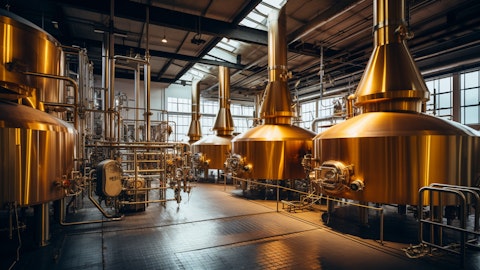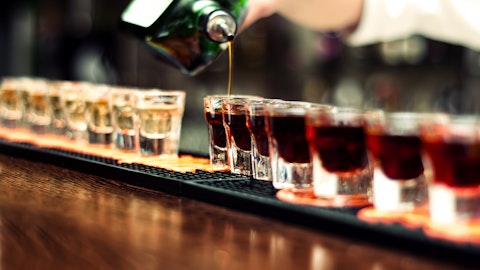Robert Ottenstein : Great. Just a few follow-ups on some of the points that have been mentioned. So Gavin, strong results. You’re obviously super confident in the business and the momentum disconnect, right, in terms of what the stock is doing, I think you’re trading at about a 10% free cash flow valuation. So given that, and I know your general points on capital allocation. I guess the question is, is there any impediments or any issues in terms of buying back stock now as in — between now and the end of the year. So is there anything to stop you from doing that? So that’s question number one. Question number 2 is just — you had mentioned that the business was better in October than in Q3. Is that global? Is that U.S., Canada and Europe? Or is it just a particular region?
Gavin Hattersley : Thanks, Rob. To your second question, I’ll take that first. It is global. It’s across the spectrum, not just the U.S. To your earlier question around why I believe and why we’re confident that we’re going to continue to deliver. I’m not going to rehash the points I made earlier about our share position have been stable for the last 25 weeks and the gains we’ve made being very sticky. But I would say to you that over the last 4 years, Robert, we made a lot — we made a number of statements when we launched our revitalization plan. We said we would streamline our company and deliver $600 million savings, and we did that. We said we would grow the top and bottom line of our business. And by the end of this year, we will have done it 2 years in a row.
We said we would strengthen our core brands, and we’ve done exactly that. we said we will become more than just a beer company, and we have become more than a beer company, we also said we would grow more of our portfolio in above premium, and we’ve done exactly that, not just in beyond beer but also in beer with a brand like Madri.
Robert Ottenstein : Sorry, Gavin, I don’t mean to interrupt you. I mean I know time’s short. I wasn’t challenging that. I was just saying, in the light of that, right, in the light of your progress, given where the stock is coming down here in the light of everything you’re saying, which I’m not challenging. Is there any impediment? Is there anything to stop you from buying back stock between now and the end of the year? And again, sorry for interrupting.
Gavin Hattersley : I’m glad you agree with all my points, Robert, I had a few more I was going to make too.
Robert Ottenstein : I am not sure that, there’s no miscommunication.
Gavin Hattersley : If we — as Tracey said, if we look at our capital allocation priorities, we’re where we need to be. We have an approved buyback program. And Robert, as we are required to do, we will disclose any and all shares that we may buy in a quarter when we when we release our Q, I think, in February of next year.
Operator: We now have the next question from the line of Nadine Sarwat of Bernstein.
Nadine Sarwat : Two questions from me. So first, with earnings clearly coming ahead of expectations today. You guys have taken a full year guidance. So that’s clearly not just a timing issue. But could you perhaps give us a sense of how much of that stronger earnings are driven by temporary versus permanent factors, perhaps particularly thinking to any temporary benefit from positive operating leverage on the fixed cost base, given shipments exceeded depletions? And then secondly, circling back to the point of market share gains, sustainability, I fully appreciate your comments on the latest scanner data and when the facts are there. I believe ABI, though quoted some survey data indicating a willingness of some lost Bud Light drinkers to return to the brand? I’d be curious to hear if you have any survey data or additional consumer insights that you could share that adds to your conviction that those market share gains will continue to be sticky.
Gavin Hattersley : Thanks, Nadine. Do you want to talk about operating leverage, Tracey, and I’ll talk about the market share gains and the stickiness.
Tracey Joubert : Yes. So Nadine, in the prepared remarks, we spoke about the volume leverage, benefiting us by about 80 basis points on the COGS per hectoliter increase. So yes, that’s for Q3, just in terms of operating leverage, our fixed cost comprises approximately 20% of our enterprise underlying COGS Obviously, volume leverage helps us with those fixed costs over more of the volume. And so as we saw in Q3, it does have a fairly significant impact — and also, that does depend on — the year-over-year does depend on the markets. In some of our markets, the fixed cost may be slightly higher. So the 20% that I’ve given you is really on an enterprise basis.
Gavin Hattersley : Thanks, Tracey. Look I don’t — I can’t really comment on Anheuser-Busch’s polling data, Nadine. But what I can say to you is that sales of what matter, right? And the sales are continuing as they have done since early April. As I said, the share gains are unchanged in 4 weeks, in 13-week and in 26 week. And in fact, in the latest 4-week read the big brand is actually getting worse. So that’s the best indication of what’s actually happening is — the share has come to us and it is sticking and has done now for 7 months. And we’ve got a bunch of plans in place, which we showed our distributors, and we revealed a little bit of it at our Strategy Day, which highlights our intention to retain that share gain.
Operator: We now have Eric Serotta of Morgan Stanley.
Eric Serotta : So coming back to U.S. brand volume. You called out the double-digits for Coors Light Banquet and the high single-digit for Miller Lite. Your overall depletions were up in mid-single digits, which implies the rest of the portfolio was a lot lower. I realize a lot of those segments are not growing but bringing life to [indiscernible] now. But can you give some color as to how your — I’d say your performance in the rest of the portfolio, either by segment or call out a couple of brands and how that is tracking versus…?
Gavin Hattersley : Yes, Eric, that was tough to catch the total drift of your question. Let me try. Obviously, there is the trading day adjustment we talked about, there is the timing of holidays, and there is the timing of the price increases that come into that. We obviously do have some total brands, which impact us. We are seeing some of the same trends as everybody else is seeing from a seltzer point of view, in particular. And that’s why we’ve taken a much more broader approach to flavor. The total flavor segment seltzers, FABs and RTDs was about 5% of the category. That number has tripled to about 13% now. It’s a $9 billion business. But there’s no question that seltzer within the flavor category is declining fairly meaningfully.




